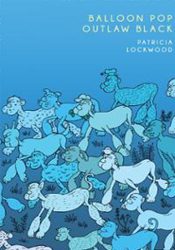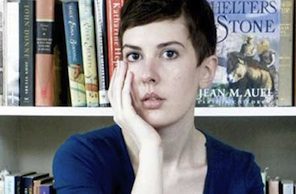
Poetry can explore philosophical ideas that are too abstract or chaotic for the usual grammar of reason. As the moorings of human culture and civilization are dislodged from place and nation and as art culture and consumer culture devour each other in Escherian permutations of natural selection while physicists discover mysteries where they used to derive laws, poetry becomes more relevant as a tool for understanding what is going on around us. Though poetry naturally grapples with the abstract, some poets leverage the philosophy of poetry to explore aspects of culture, historic events, and ideas. These poems are able to extend the effect of themselves beyond the impact of images, to the consideration of images.
What can we know about the things in our lives? What is the relationship between the thing and its properties? How do things possess their properties? In the three poem cycles of Balloon Pop Outlaw Black, Patricia Lockwood leverages the philosophical capacity of poetry to explore how mass media, the fluidity of quantum physics, and the idea of precession of simulacra, destabilize the idea of “properties,” and how that destabilization changes the relationship between the things and the properties that define them. Along the way, she writes strange, brilliant, fantastic poems.
What are the properties of a figure, recreated over and over again, represented over and over again, and experienced over and over again, so much so that people feel they have an actual relationship with that figure? What binds together an image on a poster, in a comic, on TV, or in a movie? Using an abstracted poetified version of Popeye, Lockwood explores how entities of mass culture and mass media, handled by person after person, writer after writer, illustrator after illustrator, develop a strange reality distinct from the strange reality of legendary, mythical, religious and other cultural characters like “Coyote” or “Jesus.” Though Lockwood specifically asks, “What is Popeye?” questions like “What is Batman?” or “What is Kermit the Frog?” or even “What is Marilyn Monroe?” naturally follow. This first section, “When We We Move Away From Here, You’ll See a Clean Square of Paper Where His Picture Hung,” despite being the most focused of the collection, will be difficult for most readers. Not only is Lockwood grappling with a very abstract idea, she is also establishing the act of grappling in her collection. She is simultaneously exploring a bizarre, uncertain, and confusing idea and laying the ground work for the exploration of such ideas.
 Science used to answer the bizarre, uncertain, and confusing. It used to straighten the blurry lines of endless replication into numbers and laws. But now, physics is discovering phenomena as strange as anything that can be imagined. Spooky action at a distance describes a physics of unstable properties with definitions that shift with shifting perspective. Lockwood writes, “Any piece of paper on which ‘popeye’ is printed counts as a Will, as it contains his signature, his witness, proof of his death, a list of all the property he owns, and the name of his inheritor,” creating an image of fractured singularity, as cogent a description of the madness of quarks acquiring mass through fields of energy you can find outside of equations. “The Mouth,” is filled with shuffling characteristics and in one line from “The Quickening,” she beautifully captures what it means to our experience of the world when its fundamental particles are so unstable; “When checkers are green and blue instead of red and black, they are a game about the ocean and not a game about the war.” The piece can now change color in our hands, forcing us to choose the composition of our experience. “A house in Kansas is made of Kansas. A house in the jungle is made of the jungle. The house here is made of there, is made of the air that a house displaces,” and “Inseparable things are easily separated, she knows. The name of the tea at one end of the string, the tea at the other.”
Science used to answer the bizarre, uncertain, and confusing. It used to straighten the blurry lines of endless replication into numbers and laws. But now, physics is discovering phenomena as strange as anything that can be imagined. Spooky action at a distance describes a physics of unstable properties with definitions that shift with shifting perspective. Lockwood writes, “Any piece of paper on which ‘popeye’ is printed counts as a Will, as it contains his signature, his witness, proof of his death, a list of all the property he owns, and the name of his inheritor,” creating an image of fractured singularity, as cogent a description of the madness of quarks acquiring mass through fields of energy you can find outside of equations. “The Mouth,” is filled with shuffling characteristics and in one line from “The Quickening,” she beautifully captures what it means to our experience of the world when its fundamental particles are so unstable; “When checkers are green and blue instead of red and black, they are a game about the ocean and not a game about the war.” The piece can now change color in our hands, forcing us to choose the composition of our experience. “A house in Kansas is made of Kansas. A house in the jungle is made of the jungle. The house here is made of there, is made of the air that a house displaces,” and “Inseparable things are easily separated, she knows. The name of the tea at one end of the string, the tea at the other.”
But choosing the defining properties from the quantum array, does not solve the problems of definition and property. Once you consider the idea of simulations, or copies, “preceding” their originals, and how this extends to effects “preceding” their causes, the distinction between the property and the thing it defines evaporates as well. “Below, from another world, the idea of a house was forcing itself upward, trying to come out on the other side clothed,” Is the house the property of the idea or is the idea the property of the house? Did the idea build the house or did the house build the idea? Even the material of the house won’t stand still. “It’s hard to tell where the house ends and the outside begins—the surrounding of the house almost seems to hold it up.” Is the house made of “house” or excluded space? Is the space made of “not house?” What makes the consideration of making? Precession is a rabbit hole of reason and Baudrilliard’s explication tied my brain in knots. It opens into levels of abstraction foreign to just about everybody. But poetry, by its nature, speaks to our abstract mind, the aspects of our intelligence comfortable with chaos and paradox, and so Lockwood’s images give precession a clarity I’ve never seen in philosophical writing.
Still, Lockwood wrote a collection of poems, not a treatise. Lockwood’s shorter poems are quality works as individual objects and have the intelligent strangeness I personally look for in poetry. Even when grappling with these abstract ideas, Lockwood grounds them in tangible images, giving us the opportunity to both grasp the challenging ideas and enjoy the beauty of pictures painted by words; “A year has gone by without her noticing—time does not flow smoothly here, but grows in bunches like bananas.” At least in terms of Lockwood’s poems, you don’t need to choose, all the properties are always available. Some readers will be put off by the density of this collection, especially while Lockwood is establishing the book’s project, but there is enough beautiful language throughout the philosophical exploration that I believe most poetry readers will find a lot to like. Even separated from the overall structure, “The Front Half and the Back Half of a Horse in Conversation,” “The Salesmen Open Their Trenchcoats, All Filled with Possible Names for the Watch,” “History of the House Where You Were Born,” and others are fantastic poems.
Though poetry is a useful tool for philosophy, I have to ask, what is the end result? Can poetry translate these phenomena into our more “mainstream” systems of sense-making and life-living? If not, how does its exploration inform or assist or contribute to the thoughts we intend to think and the actions we intend to take? If there is no way to carry material from one to the other, is it good, bad, or neither to have a divided consciousness as the standard operating procedure? How could we ever evaluate the material in a way that helps us live better lives as better people? And yet, the impossibility of these questions does nothing to diminish my love of poetry. It might be the source. Too many poets and poetry readers hide from this impossibility, assuming those succinct images of daily life, daily emotions, and daily nature told in daily language are fundamental. That assumption, though, is supported by avoidance; that crystal clear image is only crystal clear if you don’t look at it too hard. Once you do, it is endlessly faceted by the very impossibility it sought to avoid. Balloon Pop Outlaw Black is a bold, brilliant, intelligent, strange collection of poetry, one that transforms that impossibility from an adversary into a dance partner.




